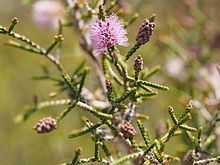Rank Species | ||
 | ||
Similar Beaufortia cyrtodonta, Beaufortia orbifolia, Beaufortia schaueri, Beaufortia, Beaufortia sparsa | ||
Beaufortia micrantha, commonly known as small-leaved beaufortia or little bottlebrush, is a plant in the myrtle family, Myrtaceae and is endemic to the south-west of Western Australia. It is a compact shrub with tiny leaves pressed against the stems and profuse heads of purple or pinkish-coloured flowers.
Contents
Description
Beaufortia micrantha is a small, compact shrub which grows to a height of about 0.5 metres (2 ft). The leaves are triangular in shape with the end tapering to a point, 1–2 millimetres (0.04–0.08 in) long and have their upper surfaces pressed against the stems, sometimes overlapping each other. The leaves of Beaufortia empetrifolia are similar in size and shape but are not pressed against the stems to the same extent.
The flowers are usually pinkish-red to purple and are arranged in heads about 10 millimetres (0.4 in) in diameter, 15 millimetres (0.6 in) long on the ends of branches which continue to grow after flowering. The flowers have 5 sepals, 5 petals and 5 bundles of stamens. The stamen bundles have 3 to 5 stamens each, are 6–10 millimetres (0.2–0.4 in) long with the free parts a further 5–10 millimetres (0.2–0.4 in) long. Flowering occurs in most months but mainly from September to November and is followed by fruits which are woody capsules 25–35 millimetres (0.98–1.4 in) long, 6–10 millimetres (0.2–0.4 in) wide and closely packed together.
Taxonomy and naming
Beaufortia micrantha was first formally described in 1843 by Johannes Conrad Schauer in Dissertatio phytographica de Regelia, Beaufortia et Calothamno. The specific epithet (micrantha) is derived from the Ancient Greek μικρός (mikrós) meaning "small" and ἄνθος (ánthos) meaning "flower".
Distribution and habitat
Beaufortia micrantha mainly occurs in and between the Esperance, Albany, Corrigin and Southern Cross districts in the Avon Wheatbelt, Coolgardie, Esperance Plains, Jarrah Forest and Mallee biogeographic regions. It usually grows in sandy soils derived from laterite on plains and ridges.
Conservation
Beaufortia micrantha is classified as "not threatened" by the Western Australian Government Department of Parks and Wildlife.
